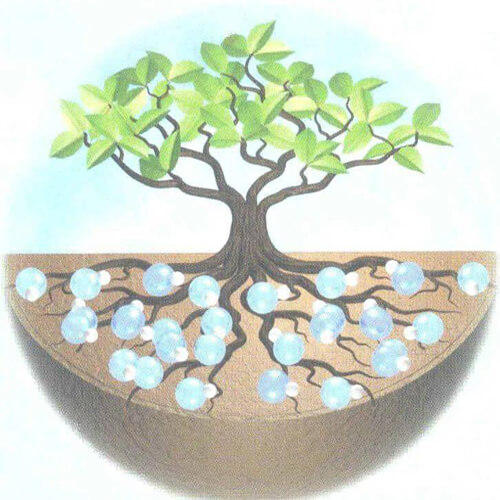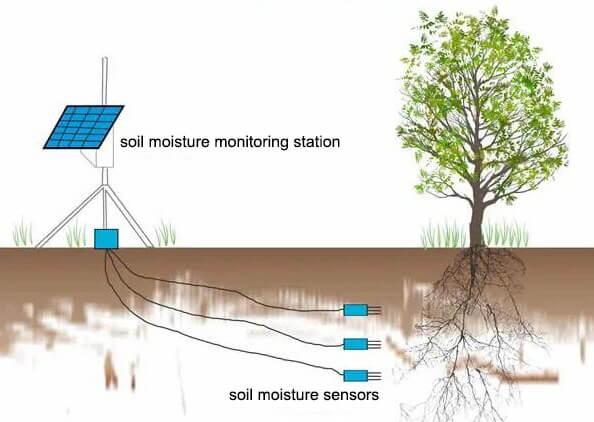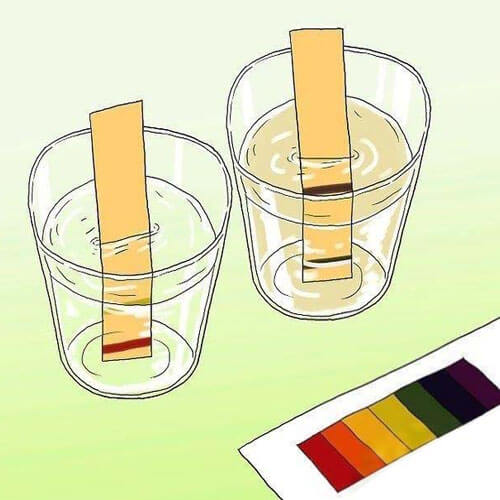What is soil water?
Soil water is a general term for all forms of water in the soil, including water present in soil pores and adsorbed by soil particles. Soil water is the main source of water absorption for plants. It comes in three main forms: vapor, liquid and solid.
Soil water is mainly derived from rainfall and irrigation water. In addition, rising groundwater and condensation of water vapor in the atmosphere are also sources of soil moisture.
Water is subjected to various forces in the soil such as gravity, capillary gravity, water molecule gravity, and molecular gravity on the surface of soil particles, forming different types of water and reflecting different properties.
- Solid water – ice crystals formed when soil water freezes.
- Vapor water – water vapor present in the soil air.
- Bound water – includes hygroscopic and membrane water.
- Free water – including capillary water, gravity water, and groundwater.
- Gravity water – water that percolates downward due to gravity.
What are the types of soil water?
1. Hygroscopic water
Hygroscopic water is a thin film of water formed by solid particles in the soil that draw water directly from the air. Its thickness and content depend on the degree of water vapor saturation in the air. In absolutely dry air, the hygroscopic water content is very small, approximately zero. Under saturated water vapor conditions, hygroscopic water reaches a maximum value. Hygroscopic water is adsorbed by solid soil particles, so the hygroscopic water content is related to soil texture, solute content and organic matter content. Because hygroscopic water is bound to soil particles, it cannot move freely and is difficult to be absorbed and utilized by plants.
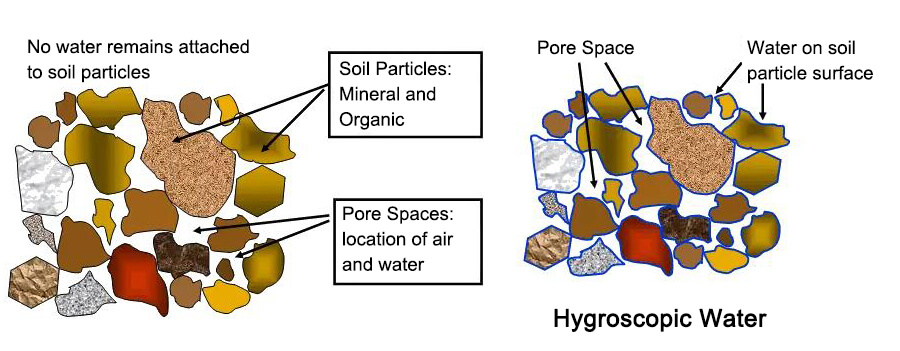
2. Film water
After the soil particles adsorb water vapor molecules to reach the maximum value, it can also adsorb more liquid water. So that the inter-particle water film interconnected to form a continuous water film, this water film wrapped around the outside of the hygroscopic water is called film water. Film water adsorption in the hygroscopic water outside, by the soil particles adsorption force is small, can move freely between the film, and from the water film thick place to the thin place to move.
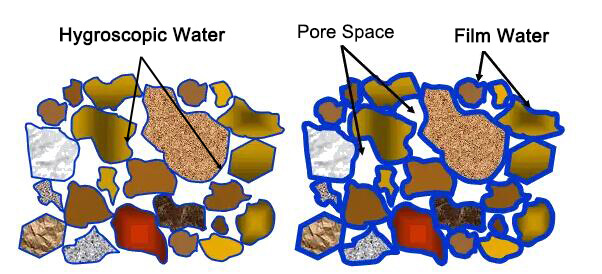
The content of film water is determined by soil texture, humus content and so on. Where the soil texture is clayey and high in humus content, the membrane water content is high. As the film water is subject to the gravitational force than hygroscopic water is small, generally pF value of 4.5 ~ 3.8, so it can be from the water film thick soil particles to the direction of the thin soil particles, but the speed of movement is slow. Film water can be absorbed by the plant root system, but the amount is small.
3. Capillary water
After the soil moisture content reaches its maximum molecular water holding capacity, soil water continues to increase and fill the soil’s capillary pores. This water held by the gravitational pull of the capillary produced by the pores in the soil is capillary water. Capillary waters are subject to less force, have a greater ability to move freely, and can be absorbed and utilized by plants. Moreover, they have the ability to dissolve chemicals in the soil and are solvents and carriers of chemicals in the soil. According to the degree of connection between soil water and groundwater, the capillary water can be divided into ascending water in capillary tube and suspended capillary water.
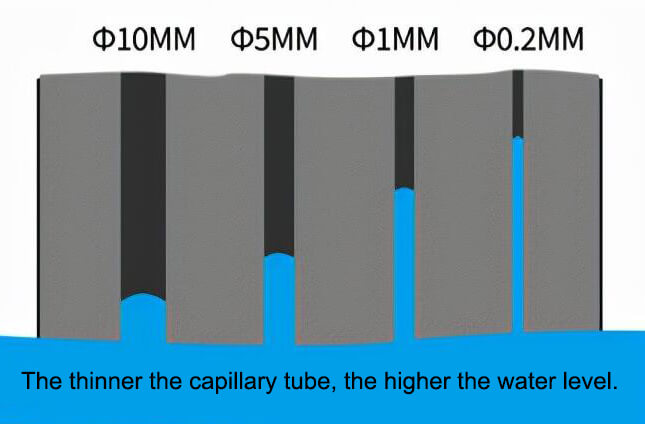
When groundwater is shallow, water rises to a certain height through the action of capillary forces, and this is called ascending water in capillary tube. This kind of water is a way for groundwater to replenish soil moisture. Plants can absorb and utilize groundwater in this way. When the groundwater is deep, water leaks downward after rainfall or irrigation, part of the water penetrates downward under gravity, while part of the water is affected by the force of the capillary and remains suspended, this is the suspended capillary water.
4. Gravittional water
When the water in the soil exceeds the effect of the action of the capillary forces, the excess water continues to move along the large capillaries in the soil under the force of gravity. This water moving under the influence of gravity is called gravity water. Gravity water has the basic characteristics of liquid water, so it can be absorbed and utilized by plants. However, because it is free to move by gravity and cannot remain in the crop root zone, most gravity water has no chance of being absorbed and utilized by plants.
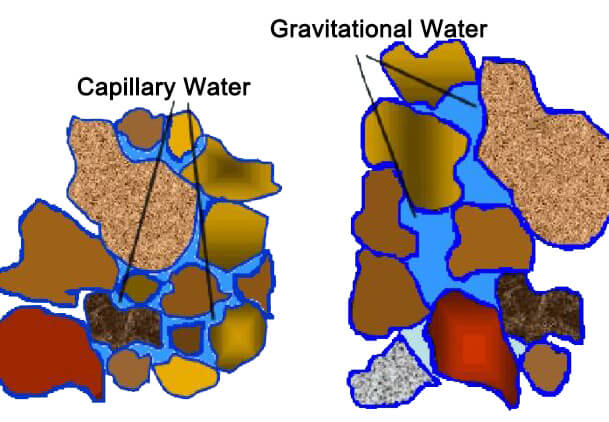
Effects of soil water on plants
Soil water begins to have an effect on the plant before the seed germinates. For example, poplar and willow seeds must come into contact with wet soil after maturation before they can take root and germinate. Seeds need moisture during germination to promote softening of the seed coat and to change the protoplasm from a gelatinous state to a sol-gelatinous state.
Because plant roots grow directly in the soil, the soil water content affects the development of plant roots. In dry soil environments, especially grassland and desert areas, plants have deep roots. On moist soils, plant roots are shallower, mostly in shallow layers of soil a few inches from the soil surface.
Water has a maximum, minimum and optimum point for plant growth. Below the minimum point, the plant wilts and growth stops. Above the maximum point, plant roots are starved of oxygen, suffocate, and eventually rot. Only within the optimum range can a plant’s water balance be ensured. Different plants require different optimum water levels. For example, horseshoe grass growing on sand dunes has an optimum soil water content of about 60%; fenugreek growing in a normal environment has an optimum soil water content of about 85%; and water spinach growing on wetlands can have an optimum soil water content of 110% or more.
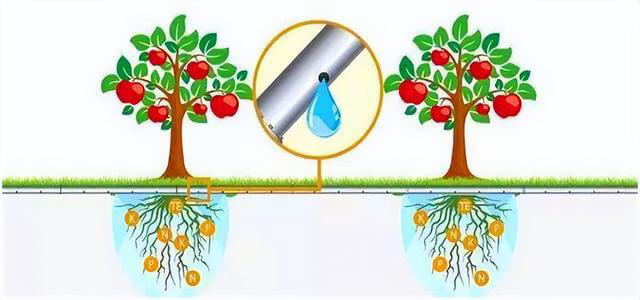
Soil water VS soil moisture
Soil moisture usually refers to the relative amount of water contained in the soil or the percentage of water content. It is a relative concept and is the ratio of water in the soil to the volume or mass of the soil, usually expressed as a percentage (e.g., 25% soil moisture) or other ratio indicator. It can be measured by soil moisture sensor, soil tensiometer, soil moisture monitor or other devices.
Soil moisture can be a dynamically changing value because the amount of water in the soil varies with time, climate, and soil type.
Soil water is the total amount of water in the soil and covers all forms of water in the soil. It includes liquid water in the soil, solid water (water adsorbed on the surface of soil particles), and gaseous water (water vapor in soil pores). It is usually expressed in units of volume or mass (e.g., cubic meters or kilograms). It can be measured by weighing.
Soil water content depends not only on soil moisture, but is also influenced by the hydraulic properties of the soil, soil structure, and climate. It is an important part of the soil hydrological cycle and influences soil ecosystem function, crop growth, hydrological processes, etc.
| Soil Texture | Sandy Soil | Sandy Loam Soil | Light Loam Soil | Medium Loam Soil | Heavy Loam Soil | Clay Soil |
|---|---|---|---|---|---|---|
| Field Water Holding Capacity(%) | 13 | 18 | 22 | 24 | 26 | 30 |
| Wilting Coefficient(%) | 3 | 5 | 6 | 9 | 11 | 15 |
| Max. Effective Water Content(%) | 10 | 13 | 16 | 15 | 15 | 15 |
How to measure soil moisture content?
1. Weighing method
The drying method is commonly used to measure soil moisture. After field sampling, soil samples are weighed first and then placed in an oven at a temperature of 105℃ for drying and then weighed. Measure the weight of the soil sample after complete drying and the weight of the soil sample before drying respectively, the weight lost by heating is the moisture content of the soil sample.
2. Soil moisture sensors
The soil moisture sensor is the most currently popular method. The sensor emits electromagnetic waves of a certain frequency, which are transmitted along the probe, reach the bottom and return, and the output voltage of the probe is detected. Since the change in soil dielectric constant usually depends on the moisture content of the soil, the moisture content of the soil can be calculated from the relationship between output voltage and moisture.
3. Resistance method
Certain porous substances such as gypsum, nylon, fiberglass, etc. Their electrical resistance is related to their water content. When such block assemblies with embedded electrodes are placed in moist soil, they absorb soil moisture and reach equilibrium. The resistance of the block assembly is determined by the soil water content. These block assemblies are used to determine the water content at selected locations in the field. They give fairly accurate moisture values in the suction range of 1 to 15 atmospheres.
4. Neutron scattering method
Neutron scattering is the use of a neutron meter to determine soil water content. The neutron meter consists of a fast neutron source and a slow neutron detector. The fast neutron source continuously emits penetrating fast neutrons in the soil. When it collides with the nucleus of a hydrogen atom, it loses the most energy and is converted into a slow neutron. Soil moisture is measured by counting the number of slow neutrons.
5. Tensiometer method
Determine the water content by measuring the soil water suction. Its measuring principle: when the clay head is inserted into the measured soil, the free water in the tube contacts the soil water through the porous clay wall, and reaches the water potential equilibrium after exchange. At this time, the value read from the soil tensiometer is the suction value of the soil water (at the clay head), and the specific value can be determined according to the relationship between soil water content and soil matrix potential.


